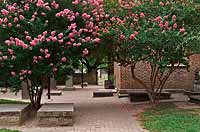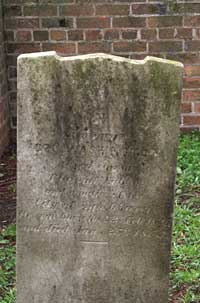Page content
Bruton Parish Churchyard

- Many buried at home in colonial times
- 17th-century graves found in land donated for second Bruton Parish Church
- Catherine Memorial Society formed to preserve gravestones
Churchyards not first choice for burial location
Colonial Virginia churchyards were not the first choices for burials. The custom was to inter the dead at home. In 1724, the Reverend Hugh Jones, Bruton Parish rector, complained about this practice because it meant he had to travel to plantations and farms to conduct funerals.
17th-century graves located in Bruton Parish Churchyard
Despite the burial customs of the era, there are 17th-century graves in the parcel of land John Page donated for the second Bruton Parish Church on November 14, 1678. Page's gift included the land 60 feet in all directions from the building. No one knows how many graves it contains, or the age of the oldest. Many of the early burials are not marked. In some instances, the lack of grave markers led to people being buried atop one another.
Archaeological excavations at the site of the second church in 1993 showed no standard depth, nor any standard orientation, for graves. Some order eventually came to grave orientation, but depths varied into the 19th century. By 1836, this was enough of a problem for the vestry to decree that all new graves had to be at least 4.5 feet deep.
Notables buried in Bruton Parish Churchyard
Graves of note include those of Governor Edward Nott, first rector Rowland Jones, the powerful Thomas Ludwell, merchant John Greenhow, and two infant children of Martha Custis Washington by her first husband. Some of their names are still heard on Williamsburg's streets, including the name of little Matthew Whaley.
In 1705, Matthew's mother buried him beneath a stone that says:
"Matthew Whaley lies Interred here
Within this Tomb upon his father dear
Who Departed
this life the 26th
of September 1705 Aged
Nine years only child
of James Whaley
and Mary his wife."
Mrs. Whaley established the Mattie Free School for the poor on Capitol Landing Road in the boy's memory. It had a schoolhouse, a master's house, and a stable. Mrs. Whaley left for England, entrusting the school's management to the Bruton Parish Church wardens. She died in 1742, leaving a legacy of about £800 to support the institution. But an executor refused to pay, resulting in a suit in chancery that dragged on past the Revolution. The wardens, unable to support the school, sold the property and earmarked the proceeds for poor relief.
Matthew Whaley School named for child buried in churchyard
In 1859, an English lawyer called the church's attention to the still-pending chancery suit. In 1867, the College of William and Mary agreed to discharge the trust of the will and used the legacy to build the Matthew Whaley Observation and Practice School on the then-vacant Governor's Palace grounds. The school stood until the 1920s, when Colonial Williamsburg acquired the property and had the school, as well as the new high school in front of it, torn down. The school John D. Rockefeller Jr. built to replace them is named the Matthew Whaley School.
Deterioration of graveyard noted in newspaper editorial in 1825
As the city's fortunes faded after the Revolution, so did those of the graveyard. Daniel Walker Lord of Kennebunkport, Maine, came through Williamsburg in 1824. He wrote of the church, "There is a burial ground around it, some of the tombs are marked as early as 1693. . . . The tombs in the yard have most fallen down, and look as though their friends are all extinct."
The Phoenix Gazette, a Williamsburg newspaper, reported in the midst of a campaign for a city graveyard in 1825, "It is with a feeling of sadness that we see the rapid decay of the monuments in the old churchyard of Bruton Parish. One by one they are crumbling, and like the beings whose virtues they were erected to commemorate, they will soon be passed away."
Martha Vandergrift visited Williamsburg as a child in 1844 and 1845 to see relatives. She recalled years later, "We used to jump from one tombstone to another. I always felt that I had a right to, as many of them marked the graves of my Page ancestors."
Wounded Yankees and Confederates rested in graveyard awaiting treatment

After the Battle of Williamsburg on May 5, 1862, the church became a Union hospital for Yankees and Confederates. Many of the wounded were laid in the graveyard to await treatment or to recuperate. Witnesses said their blood stained many of the tablet stones. Some of the dead are buried in graves near the north wall, but there are few names on the markers.
As Matthew Whaley's headstone illustrates, graveyard inscriptions were sometimes elaborate. A 19th-century Baptist preacher, the Reverend Scervant Jones, was beloved for his wit and his rhymes. Jones buried his first wife in the Bruton Parish graveyard under a stone he brought to Williamsburg on the roof of the same stagecoach he used to carry his second wife to the city. The tablet reads:
"Here lies all that the grave can claim of
Mrs. Ann Timson Jones
Consort of the
Rev. Scervant Jones
Born 1st Sept. 1787
Married 26 Dec. 1805
Baptized 3 Mar. 1822
Died June 6, 1849
If woman, ever yet did well;
If woman, ever did excel;
If woman, husband ere adored;
If woman, ever loved the Lord;
If faith and hope and love;
In Human flesh did live and move;
If all the graces ere did meet;
In her they were complete.
My Ann, my all, my angel wife,
My dearest one, my love, my life,
I cannot sigh or say farewell;
But where thou dwellest I will dwell."
A vestry book minute of March 9, 1897, says that two of their number, Drs. Moncure and Garrett, were appointed to a committee "to so fix the gates that cattle may be prevented from trespassing in the churchyard." There are scattered notes in the minute book of people seeking permission to raise fences around family plots to preserve them from wandering animals.
But a minute of April 5, 1907, says: "On motion it was decided that all persons interested in the fences in the church yard be earnestly requested to remove the same at their earliest convenience as it is the unanimous opinion of the Vestry that in view of the city ordinance of Williamsburg prohibiting the running at large of cows and horses, that in their opinion, no occasion now exists for enclosures in the Church Yard."
Cynthia Beverley Tucker Coleman began restoration efforts to honor her daughter
So far as the record shows, restoration efforts in Williamsburg began in 1884 when Cynthia Beverley Tucker Coleman organized a group of children into the Catherine Memorial Society. The name honored her daughter, who had died at age 12 the year before. On April 7, 1887, the society requested permission of the vestry "to repair the old monuments in the Church Yard and to otherwise put in order the yard, as their means may justify."
The society repaired broken headstones and put brick foundations beneath some tablets resting on the ground. The society is credited with stimulating the interest in restoration that grew into establishment of the Association for the Preservation of Virginia Antiquities, an organization that Mrs.Coleman cofounded. Mrs. Coleman was the owner of the St. George Tucker house and a descendant of its namesake. She was also responsible for saving the crumbling Williamsburg Magazine.
